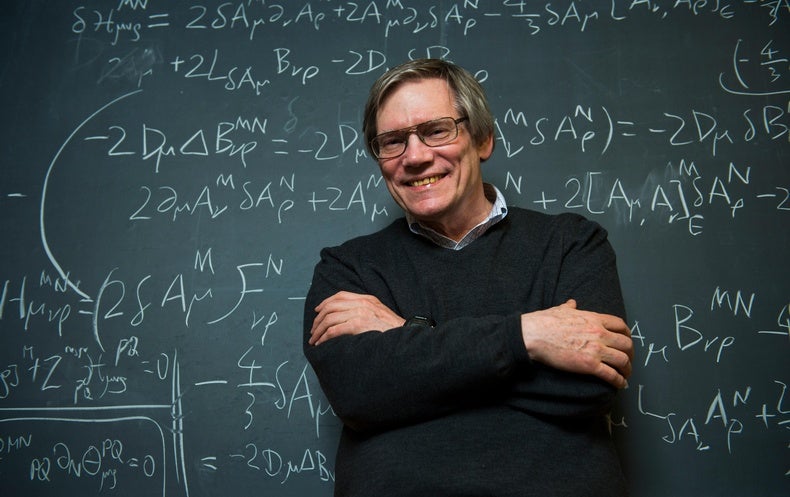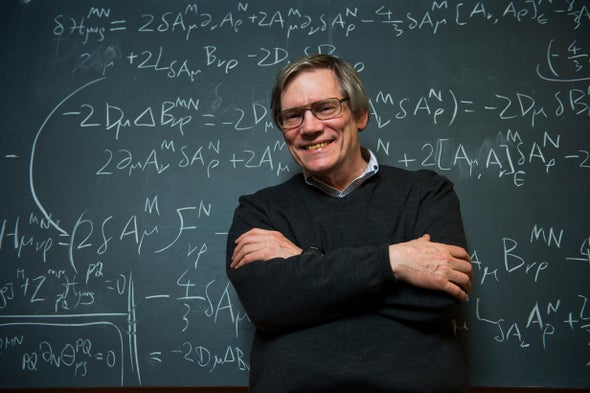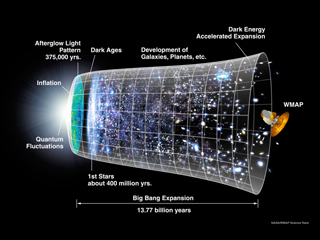Alan Guth: The Father of Cosmic Inflation
The realm of cosmology, the study of the universe's origins, structure, evolution, and eventual fate, has long been a domain filled with profound mysteries and grand theories. Among the most groundbreaking contributions to this field is the theory of cosmic inflation, a revolutionary idea proposed by Alan Guth—a name that stands etched in the annals of science for his pivotal role in reshaping our understanding of the universe's earliest moments.
The Early Years and Academic Journey
Born on February 27, 1947, in New Brunswick, New Jersey, Alan Guth became captivated by the wonders of science at a young age. His early interests were piqued by a penchant for delving into the intricacies of physics and mathematics, driven by a thirst for knowledge about the fundamental workings of the universe. This intellectual curiosity led him to pursue physics at the Massachusetts Institute of Technology (MIT), where he would later make his mark.
After achieving a Bachelor of Science degree in physics in 1969, Guth continued to explore his passion by earning a Ph.D. from the same institution in 1972. His doctoral work focused on particle physics—a field concerned with the study of the subatomic particles that form the fundamental building blocks of matter. As Guth embarked on his academic journey, little did he know that he was on the cusp of a discovery that would dramatically alter cosmological theories and inspire a new era of exploration.
The Advent of Cosmic Inflation
The 20th century witnessed a flourishing of theories attempting to unravel the mysteries of the universe. Among the most prevalent was the Big Bang theory, postulating that the universe began from an extremely hot and dense state and has been expanding ever since. Yet, despite its success in explaining many cosmic phenomena, the Big Bang theory left several questions unanswered. For instance, why is the universe so homogeneous, with a smooth distribution of galaxies visible even in distant regions? Why is space flat, counteracting expectations that it should possess a more varied curvature?
Alan Guth's foray into cosmology came somewhat accidentally. In the late 1970s, while working on problems related to particle physics, he stumbled upon an idea that tied together puzzling aspects of the universe's early moments with concepts from particle physics. His eureka moment came in December 1979, when he conceived the notion that the universe underwent a rapid exponential expansion—growing from subatomic scales to cosmic proportions in a fraction of a second. This theory, dubbed "cosmic inflation," offered elegant solutions to long-standing cosmological puzzles.
Inflation: A Paradigm Shift in Cosmology
Cosmic inflation introduced the idea that following the Big Bang, the universe expanded at an unimaginably fast rate, faster than the speed of light, during the first tiny fraction of a second. This notion provided a compelling explanation for the universe's observed uniformity. The exponential expansion smoothed out any irregularities, resulting in the vast, homogeneous cosmos we observe today.
Furthermore, inflation theory illuminated why the universe appears flat. The rapid expansion would have stretched out any initial curvature to a point where it would be indistinguishable from flatness on observable scales. This concept significantly bolstered the Big Bang theory by addressing these inherent discrepancies and providing a cohesive framework that aligned with observational data.
A Legacy Cemented in Scientific Exploration
Alan Guth's introduction of cosmic inflation marked a monumental shift in theoretical physics and cosmology. The theory garnered substantial interest and scrutiny, leading to a flourishing dialogue and subsequent developments within the scientific community. Notably, it spurred further research into the early universe, fueling advancements in our understanding of fundamental physics and the behavior of the universe at the most extreme scales.
Inflationary theory does more than just explain the universe's current state; it also suggests the presence of multiple realities, known as the "multiverse." According to some interpretations, our universe might be just one of countless other inflationary bubbles, each potentially governed by different physical laws. This notion has led to vibrant discussions and explorations into the nature of reality itself.
In our continuing quest for knowledge, Alan Guth’s work remains pivotal, inspiring a new generation of physicists and cosmologists to probe deeper into the origins of the universe. His contributions form the bedrock upon which modern cosmology stands, opening doors to insights that challenge and enrich our comprehension of everything from the largest scales of cosmic structure to the smallest entities of matter. As the story of the cosmos unfolds, Alan Guth’s legacy as the father of inflation continues to echo through the corridors of scientific thought.
A Dynamic Exchange of Ideas
The introduction of cosmic inflation was not just a scientific milestone; it initiated a vibrant discourse that spanned across the scientific community, inviting astronomers, cosmologists, and particle physicists to contribute perspectives and refinements to the theory. This era of dynamic exploration saw the convergence of multiple branches of physics—quantum mechanics, general relativity, and astrophysics—fostering an interdisciplinary approach to unravel the universe's intricate tapestries.
One of the most critical elements in this intellectual venture was the development of the concept of "quantum fluctuations." According to quantum mechanics, random fluctuations occur at the smallest scales, even in a seemingly empty vacuum. During the inflationary epoch, these minute fluctuations were amplified to macroscopic scales. This theory posited that the tiny differences in density became the seeds for the formation of galaxies and large-scale structures observed in the universe. Hence, inflation not only accounts for the cosmological sameness on a grand scale but also explains the tiny imperfections that led to the rich, clumpy universe filled with stars, planets, and galaxies.
Inflationary Theory Under the Lens of Observation
Science thrives on experimental validation, and the theory of cosmic inflation was no exception. As Guth put forth his revolutionary ideas, the scientific community embarked on a mission to gather quantitative evidence to either corroborate or challenge the predictions of inflationary cosmology. One of the critical tests came from the cosmic microwave background (CMB), the faint relic heat of the Big Bang, which serves as a snapshot of the early universe.
The precision measurements of the CMB, particularly those obtained by experiments such as NASA's Cosmic Background Explorer (COBE) in the 1990s, the Wilkinson Microwave Anisotropy Probe (WMAP) in the 2000s, and more recently the Planck satellite, brought to light patterns consistent with predictions from inflationary models. These observations revealed tiny variations in temperature, which matched the theoretical frameworks indicating that quantum fluctuations were indeed magnified at the dawn of time.
Additionally, the large-scale structure of the universe, mapped in detail by galaxy surveys, provided further support, aligning with the predicted patterns of density variations resulting from inflation. The combination of these observations produced a robust case for inflation, weaving an intertwined narrative of theoretical insight and empirical evidence.
Challenges and New Frontiers
Despite its successes, cosmic inflation is not devoid of challenges or controversies. One of the primary questions revolves around the mechanics that started and subsequently stopped inflation. The process needs a precise mechanism to transition from the rapid exponential expansion to the slower rates of expansion seen today. This transition involves hypothesizing new physics, as the inflaton, a postulated scalar field responsible for driving inflation, requires properties that have yet to be fully understood or observed in particle experiments.
Furthermore, the concept of the multiverse, though a fascinating extension of Guth's initial insights, generates significant philosophical and scientific debate. If other universes exist, inherently beyond our observational reach, how might we devise methods to understand or even detect their presence? This remains a frontier of scientific inquiry, spurring a multitude of theoretical propositions and debates regarding the nature of existence itself.
In pursuit of these answers, advancements in technology and observational prowess continue to be instrumental. Future endeavors, including more sophisticated space telescopes and particle accelerators, promise to probe deeper into the primordial universe, potentially revealing phenomena beyond current understanding. Such pursuits will not only test the boundaries of inflation but also broaden our comprehension of quantum physics, gravity, and the fabric of spacetime itself.
Inflation's Broader Implications
The far-reaching implications of inflation extend beyond the realm of cosmology, influencing a broad spectrum of scientific thought and philosophy. By integrating principles from particle physics with cosmological models, inflation provides a fertile ground for unifying the macroscopic and microscopic aspects of the universe, inching closer to the elusive theory of everything that physicists aspire toward.
Moreover, the philosophical underpinnings of cosmic inflation and the multiverse concept invite contemplation on our place in the grand cosmic scheme. If our universe is just one of potentially infinite others, what does that mean for the uniqueness of our cosmic history, or even our existential significance? These ruminations extend into the humanities, inspiring dialogue across disciplines as varied as philosophy, theology, and metaphysics.
As we stand at the confluence of discovery and understanding, Alan Guth's pioneering contributions continue to illuminate pathways, challenging us to explore and question not just the universe we inhabit, but the myriad possibilities that lie beyond. The journey, enriched by past and present insights, propels onward, daring us to redefine the horizons of human knowledge.
The Human Element: Alan Guth's Influence and Vision
Beyond the equations and theoretical constructs, Alan Guth's influence resonates deeply on a personal and educational level. As a professor at MIT, Guth has been instrumental in cultivating a culture of inquiry and intellectual curiosity among his students. His mentorship has launched numerous careers in physics and cosmology, instilling a passion for exploring the universe’s most profound mysteries, encouraging students to ask bold questions, and bridging the gap between known science and theoretical possibilities.
Guth's dedication to education is reflected in his ability to communicate complex ideas effectively, both in academic circles and to the broader public. Through his lectures and publications, particularly his acclaimed book "The Inflationary Universe," he has made intricate cosmological concepts accessible to non-specialists. His efforts have garnered appreciation not just for their scientific merit but for inspiring public interest in the wonders of physics and cosmology.
A Continuing Journey Through Space and Time
Even as cosmic inflation continues to be rigorously tested and refined, Guth remains actively engaged in pushing the boundaries of knowledge. He collaborates with researchers worldwide to address unresolved questions and explore new facets of inflationary theory. His presence at conferences and symposia serves as an invaluable source of inspiration and guidance, demonstrating the importance of perseverance and creativity in scientific exploration.
As research advances, discussions have expanded to include ideas about eternal inflation—a variant suggesting that inflationary processes could be everlasting, continuously giving birth to new "pocket" universes. These developments invite further theoretical innovations, sowing seeds for future breakthroughs that could transform our understanding of reality itself.
A Legacy Beyond Academia
While Guth is widely recognized for his scientific contributions, his legacy extends beyond research and academia. He is a shining example of how scientific inquiry can be deeply human, filled with moments of serendipity, relentless curiosity, and a profound desire to unravel the universe's secrets. His journey reflects the quintessential scientific spirit—a willingness to rethink existing paradigms and embrace uncertainty in the pursuit of truth.
Moreover, Guth's work underscores the importance of interdisciplinary collaboration, demonstrating how breakthroughs often occur at the intersections of different fields. By forging connections between particle physics and cosmology, Guth's inflationary theory serves as a testament to the power of collaborative innovation.
His pioneering vision and contributions have not gone unnoticed, earning him numerous accolades, including the prestigious Kavli Prize in Astrophysics and election to fellowships such as the American Academy of Arts and Sciences. Yet his most enduring legacy lies in the realm of possibility—in sparking the curiosity of future generations and paving new avenues of discovery.
The Cosmic Tapestry Unfolds
In contemplating Alan Guth's journey and the profound impact of cosmic inflation, we are reminded that science is a dynamic, ever-evolving dialogue with the universe. Each discovery, each innovation brings us closer to answering foundational questions about the nature of existence—revealing the universe not just as a vast expanse of matter and energy but as a living tapestry adorned with beauty and complexity.
As we stand on the shoulders of giants like Guth and his contemporaries, we find ourselves at the precipice of a deeper understanding of both the cosmos and our own role within it. The questions that remain—about the origins, mechanisms, and ultimate fate of the universe—continue to inspire and challenge us, propelling humanity into an era of exploration rich with promise and wonder.
Alan Guth's story is one of scientific revelation and human perseverance. His work exemplifies the transformative power of ideas, revealing how moments of insight can illuminate vast cosmic truths. As we gaze at the night sky, filled with stars and galaxies born from the inflationary epoch, we do so with newfound appreciation and curiosity, inspired by the enduring contributions of a visionary mind. In this ever-unfolding journey through the universe, Guth’s legacy endures, energizing future explorations and igniting the imaginations of those who dare to dream beyond the stars.








Comments